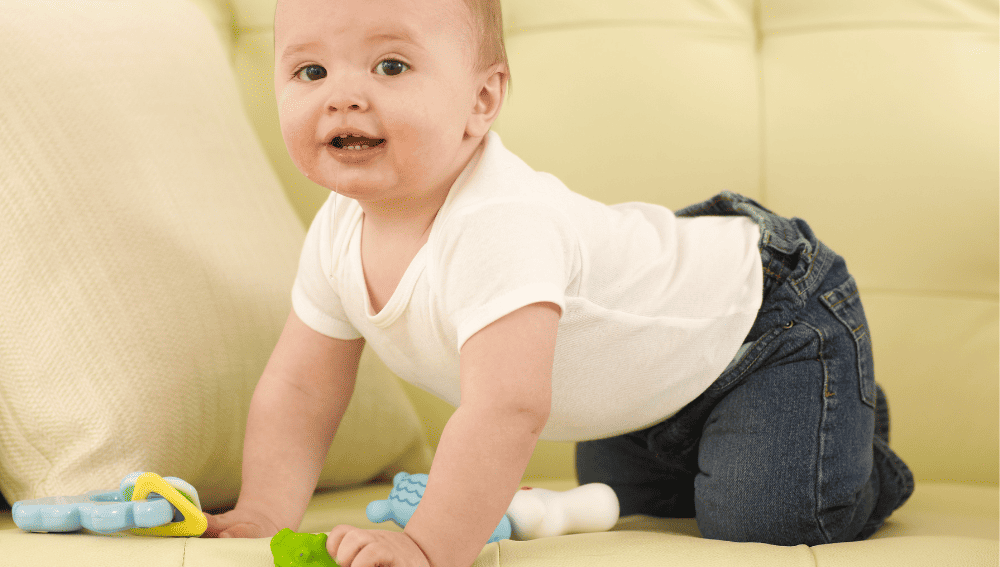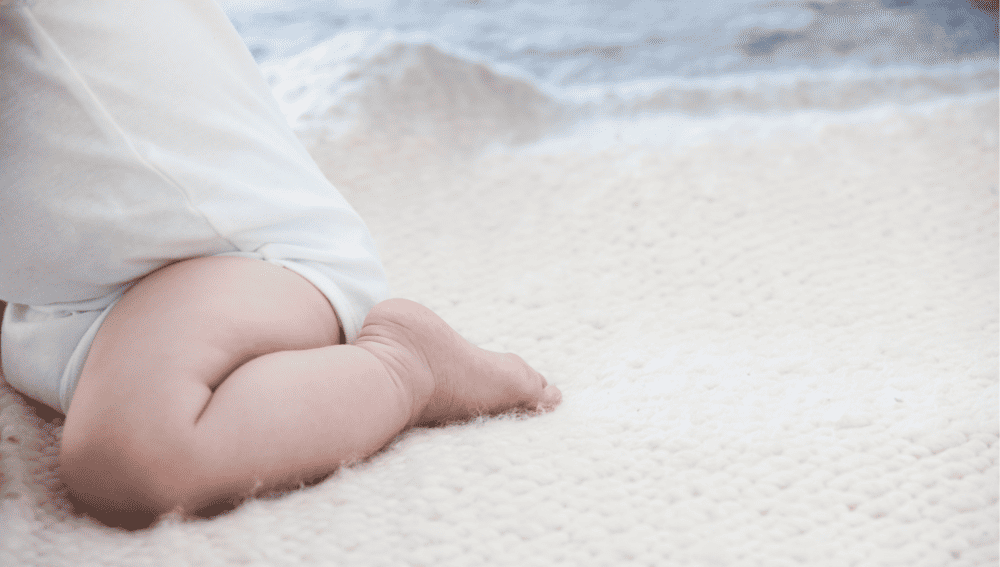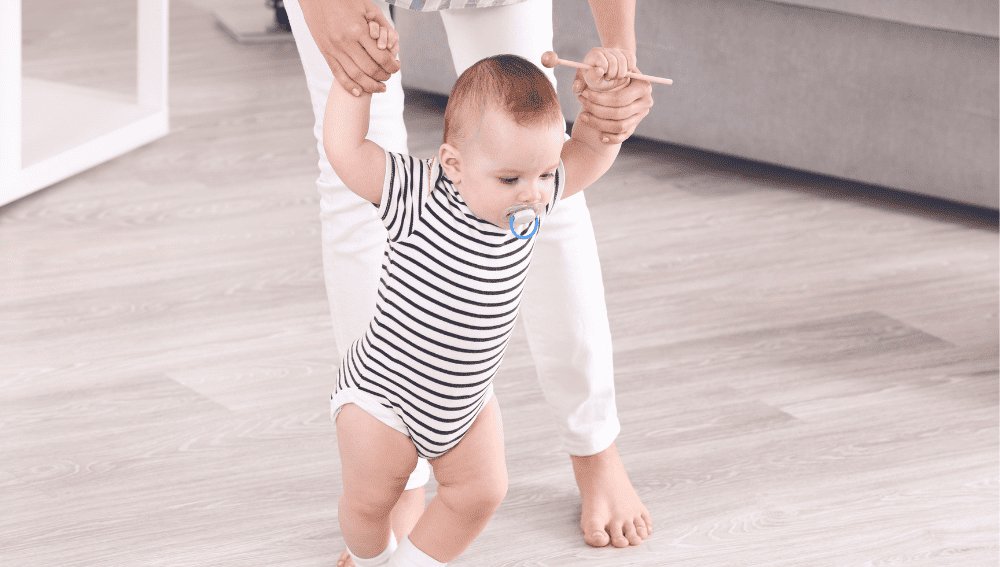Babies are fascinating creatures, and their development is always a source of curiosity and interest for parents, caregivers, and healthcare providers alike.
One of the most intriguing aspects of babies’ development is their locomotion, and the various ways they learn to move their bodies. While most babies learn to crawl and then walk, some babies may develop unique ways of moving, such as walking on their knees.
Understanding babies’ locomotion is crucial to identifying any potential issues or delays in their development. Babies typically progress through various motor skills, such as rolling over, crawling, standing, and walking.
However, some babies may skip some of these milestones or develop unusual patterns of movement. Knee walking is one such pattern, and it can be a cause for concern for parents and healthcare providers.
Key Takeaways:
- Knee walking is a unique pattern of movement that some babies may develop.
- Understanding babies’ locomotion is essential for identifying any potential issues or delays in their development.
- Pediatricians and physical therapists play a vital role in assessing and addressing any physical challenges in babies, including knee walking.
Understanding Babies’ Locomotion
Babies’ locomotion is an important aspect of their development. It is a gradual process that involves the development of motor skills, which enable them to move around and explore their environment.
There are different stages of locomotion that babies go through, including crawling, creeping, rolling over, and walking.
Crawling
Crawling is the first stage of locomotion for most babies. It usually starts between six to ten months of age.
During this stage, babies move around on their hands and knees, using their arms and legs to propel themselves forward. Crawling helps babies develop their upper body strength and coordination.
Creeping
Creeping is a stage of locomotion that comes after crawling. It involves moving around on hands and knees, but with the belly off the ground. This stage usually starts around eight to eleven months of age. Creeping helps babies develop their lower body strength and coordination.
Rolling Over
Rolling over is a stage of locomotion that comes before crawling. It involves rolling from the back to the stomach and vice versa. This stage usually starts around four to six months of age. Rolling over helps babies develop their core strength and coordination.
Walking
Walking is the final stage of locomotion for most babies. It usually starts around twelve to fifteen months of age. During this stage, babies move around on their feet, using their legs to propel themselves forward. Walking helps babies develop their balance and coordination.
In conclusion, understanding babies’ locomotion is important for parents and caregivers. It helps them provide the necessary support and encouragement for babies to develop their motor skills and explore their environment.
The Progression of Motor Skills
Babies go through a series of developmental milestones as they grow and learn to move around on their own. One of the most significant milestones is learning to walk independently.
However, before they can achieve this, they must first progress through a series of motor skills, including standing, pulling up, cruising, and walking on their knees.
The first step in this progression is standing. Babies typically learn to stand by pulling themselves up using furniture or other objects.
This requires a lot of upper body strength and balance, which they gradually develop over time. Once they can stand on their own, they may begin to take small steps while holding onto furniture or someone’s hand.
The next step is pulling up. This involves pulling themselves up to a standing position without the aid of furniture or other objects. This requires even more strength and balance, and babies will often fall down many times before mastering this skill.
Cruising is the next step in the progression. This involves walking while holding onto furniture or other objects for support. Babies will often take a few steps and then grab onto something to steady themselves before taking a few more steps.
Finally, babies will begin to walk independently. This is the ultimate goal of the progression and requires a lot of practice and patience. Babies will often take a few steps and then fall down, but with time and practice, they will eventually be able to walk on their own.
Walking on knees is another skill that babies may develop during this progression. While it is not a necessary step in learning to walk independently, it can be a useful intermediate step.
Walking on knees allows babies to move around more easily than crawling, but without the risk of falling that comes with walking on two feet.
In conclusion, the progression of motor skills is an important part of a baby’s development. Through standing, pulling up, cruising, and walking on their knees, they gradually build the strength and balance necessary to walk independently.
While each baby may progress at their own pace, with practice and patience, they will eventually achieve this important milestone.
Knee Walking in Babies
Knee walking is a common phenomenon observed in babies who are learning to walk. It is also known as crawling on the knees or knee crawling. Knee walking is a natural part of a baby’s physical development and is not a cause for concern.
There are several reasons why babies may choose to knee walk instead of walking on their feet. One of the primary reasons is that it provides more stability and balance, which is crucial for babies who are still developing their motor skills.
Knee walking also allows babies to move around more quickly and efficiently, which can be helpful when they are exploring their environment.
While knee walking is generally considered normal, there are some cases where it may be a sign of an underlying issue. For example, babies who have hip dysplasia or other musculoskeletal conditions may prefer to knee walk instead of walking on their feet.
In these cases, it is important to consult a pediatrician or physical therapist to ensure proper diagnosis and treatment.
Parenting plays a significant role in a baby’s physical development, including their walking habits. Encouraging babies to crawl and explore their environment can help them develop their motor skills and build confidence.
Providing a safe and stimulating environment for babies to explore can also help them learn to walk on their feet more quickly.
In conclusion, knee walking is a normal part of a baby’s physical development and is not a cause for concern. While it may be a sign of an underlying issue in some cases, most babies will outgrow knee walking as they develop their motor skills.
Parents can help support their baby’s physical development by providing a safe and stimulating environment for them to explore.
Physical Challenges in Babies
As babies develop their motor skills, they may encounter physical challenges that affect their ability to crawl, stand, and walk.
Some of the most common challenges include low muscle tone, poor joint alignment, joint instability, muscle weakness, flat feet, bow legs, pigeon toes, knock knees, leg length discrepancy, and hip dysplasia.
Low muscle tone, also known as hypotonia, can make it difficult for babies to control their movements and maintain proper posture.
This can affect their ability to crawl and walk. Poor joint alignment and joint instability can also make it difficult for babies to move properly, as their joints may not be properly aligned or supported.
Muscle weakness can also be a challenge for babies, as it can affect their ability to move and control their movements. This can be especially challenging for babies who are learning to crawl and walk.
Flat feet, bow legs, pigeon toes, and knock knees are all common conditions that can affect a baby’s ability to walk. These conditions can affect the alignment of the legs and feet, making it difficult for babies to walk properly.
Leg length discrepancy can also be a challenge, as it can cause one leg to be shorter than the other, making it difficult to walk.
Hip dysplasia is another condition that can affect a baby’s ability to walk. This condition occurs when the hip joint is not properly formed, which can cause pain and difficulty walking.
Overall, there are many physical challenges that babies may face as they develop their motor skills. It is important for parents to be aware of these challenges and to work with their pediatrician and physical therapist to address them.
With proper care and support, most babies are able to overcome these challenges and develop the skills they need to crawl, stand, and walk.
Role of Pediatrician and Physical Therapist
When it comes to babies walking on their knees, both pediatricians and physical therapists play an important role in evaluating and creating a treatment plan for the child.
Pediatricians are often the first point of contact for parents who are concerned about their child’s development. They can conduct a physical examination, review the child’s medical history, and refer the child to a physical therapist if necessary.
Pediatricians can also provide guidance on age-appropriate milestones and suggest activities that parents can do at home to promote healthy development.
Physical therapists, on the other hand, specialize in evaluating and treating movement disorders. A pediatric physical therapist can assess a child’s muscle strength, range of motion, and coordination.
They can also identify any underlying conditions that may be contributing to the child’s inability to walk on their feet.
Once the child has been evaluated, a treatment plan can be developed. This may include exercises to improve muscle strength and coordination, as well as activities to promote balance and stability. In some cases, assistive devices such as braces or walkers may also be recommended.
It’s important for parents to work closely with both their pediatrician and physical therapist to ensure that their child receives the best possible care. By working together, they can help the child achieve their full potential and reach important developmental milestones.
Therapeutic Interventions
Physical therapy is often recommended as a therapeutic intervention for babies who walk on their knees. Physical therapy can help to strengthen the muscles in the legs and improve overall mobility.
Strengthening exercises can be used to target specific muscle groups, such as the quadriceps and hamstrings, to improve the baby’s ability to stand and walk.
Postural correction is another therapeutic intervention that can be used to help babies who walk on their knees.
This involves correcting the baby’s posture and alignment to improve their overall balance and stability. This can be done through exercises that focus on improving core strength and balance.
Massage can also be used as a therapeutic intervention for babies who walk on their knees. Massage can help to improve circulation, reduce muscle tension, and promote relaxation. This can help to improve the baby’s overall mobility and reduce discomfort and pain.
Vestibular exercises can be used to improve the baby’s balance and coordination. These exercises involve stimulating the vestibular system, which is responsible for balance and spatial orientation. This can be done through activities such as rocking, spinning, and bouncing.
Orthotics, bracing, and casting can also be used as therapeutic interventions for babies who walk on their knees. These devices can help to improve the baby’s overall alignment and stability, and can also provide support and protection for the legs and feet.
Surgery is generally not recommended as a first-line treatment for babies who walk on their knees. However, in some cases, surgery may be necessary to correct underlying structural abnormalities or to improve overall mobility and function.
Parental Support and Activities
When babies start walking on their knees, it is essential for parents to provide support and activities that can help them develop their motor skills. Parents can engage in various activities with their babies to encourage them to walk on their knees and build their confidence.
One of the most effective ways to support babies is by playing games with them. Games that involve crawling, such as peek-a-boo or crawling through tunnels, can help babies develop their muscles and coordination.
These games can also help babies overcome their separation anxiety and feel more comfortable exploring their surroundings.
Parents can also encourage their babies to walk on their knees by holding onto furniture or other stable objects. This will help babies build their balance and confidence while exploring their environment.
As babies become more confident, parents can gradually reduce their support and encourage them to walk on their own.
Clapping is another great activity that parents can do with their babies. Clapping can help babies develop their hand-eye coordination and improve their motor skills. Parents can encourage their babies to clap along with them or use toys to make clapping sounds.
Overall, parental support and engaging activities are crucial for babies who are learning to walk on their knees. By providing a safe and supportive environment, parents can help their babies develop their motor skills and build their confidence.
Unusual Walking Patterns
Babies typically start walking on their feet between 9 to 18 months of age. However, some babies may exhibit unusual walking patterns during this developmental stage. These patterns may include toe walking, limping, or walking sideways.
Toe walking is when a baby walks on their toes rather than on their feet. This pattern is commonly seen in toddlers and is usually not a cause for concern.
However, if the baby continues to walk on their toes after the age of three, it may be a sign of an underlying condition such as cerebral palsy or muscular dystrophy.
Limping is another unusual walking pattern that may be a cause for concern. It can be caused by a variety of factors such as an injury, infection, or a congenital condition. If a baby is limping, it is important to seek medical attention to determine the underlying cause.
Walking sideways is also an unusual walking pattern that may be seen in babies. This pattern may be caused by a muscle imbalance or weakness in the legs. It is important to address this issue early on to prevent any further complications.
In conclusion, unusual walking patterns in babies may be a cause for concern and should be addressed by a medical professional. Parents should keep an eye out for any unusual walking patterns and seek medical attention if they notice any issues.
Conclusion
In conclusion, babies walking on their knees is a common occurrence that can be observed in many infants. This behavior is typically seen in babies who are in the early stages of learning how to walk and may be related to their balance and coordination development.
During this stage, primitive reflexes such as the tonic labyrinthine reflex (TLR) may still be present, which can impact a baby’s ability to stand up and walk without support.
This reflex causes a baby to extend their legs and arch their back when lying on their back, making it difficult for them to stand up.
However, as a baby grows and develops, these reflexes become inhibited, and they gain the ability to stand and walk without support. It is important to note that every baby develops at their own pace, and some may start walking on their knees earlier or later than others.
While this behavior may seem unusual or concerning to some parents, it is generally not a cause for alarm. As long as a baby is meeting their developmental milestones and showing progress in their balance and coordination, there is no need to worry.
Overall, parents should continue to encourage their baby’s development by providing a safe and supportive environment for them to explore and practice their newfound skills.
With time and practice, babies will eventually learn to stand and walk on their own, without the need for crawling on their knees.
Frequently Asked Questions
Is knee walking a sign of autism?
Knee walking is not a definitive sign of autism. However, some children with autism may prefer to walk on their knees or toes, so it’s important to monitor other developmental milestones and consult with a healthcare provider if there are any concerns.
When should I be concerned about my baby walking?
If your baby is not walking by 18 months of age or is walking with an abnormal gait, it’s important to consult with a healthcare provider to rule out any underlying medical conditions or developmental delays.
Why does my toddler walk with bent knees?
Toddlers may walk with bent knees due to a variety of reasons, including muscle weakness, tightness, or coordination issues. It’s important to consult with a healthcare provider if you have concerns about your toddler’s walking pattern.
What is the position of baby’s feet when walking?
When babies first start walking, their feet may be turned inward or outward. However, as they gain strength and coordination, their feet should gradually straighten out and point forward.
How to stop knee walking?
If your child is knee walking and you’re concerned, it’s important to consult with a healthcare provider to rule out any underlying medical conditions or developmental delays. In some cases, physical therapy or other interventions may be recommended to help your child learn to walk in a more typical pattern.
Is knee walking normal?
Knee walking is not typical and may be a sign of an underlying condition. However, some children may choose to knee walk as a temporary preference. It’s important to consult with a healthcare provider if you have concerns about your child’s walking pattern.
Read more on toddler development: When Should A Child Be Able To Count To 10

Iesha is a loving mother of 2 beautiful children. She’s an active parent who enjoys indoor and outdoor adventures with her family. Her mission is to share practical and realistic parenting advice to help the parenting community becoming stronger.




